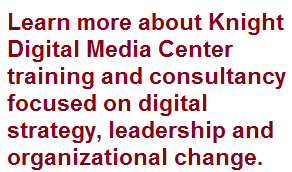Digital Leads: 10 keys to newsroom transformation
EXECUTIVE SUMMARY
Ten key elements were consistently present in the newsrooms that saw the most success. This report is organized around these elements:
- Strategy: The initiative was grounded in an overarching corporate strategy for multiplatform journalism that set a high standard but was flexible enough to evolve over the life of the initiative and to be adapted as necessary by each newsroom. It sought to focus efforts on watchdog, data, real-time, and grassroots journalism and on intensive coverage of “franchise topics,” unique coverage of high interest to potential digital subscribers. More info>>
- Research: The company provided local consumer research to help newsrooms identify potential topics of high interest to target groups, generally younger than 55, who wanted their news and information on digital platforms. More info>>
- Staff ownership: To foster staff ownership of changes, newsroom leaders appointed staff committees to determine key coverage priorities based on the research. The leaders took on the role of facilitator. More info>>
- Process: Creating a consumer-focused newsroom culture was critical, so the process was designed to connect journalists with digital news consumers. Each newsroom committee identified two to four local “franchise” topics of high interest to specific target demographic groups. Then committee members interviewed dozens of people from these groups. They learned about their interests and media consumption habits, including which devices they used and when. Based on the interviews, the journalists created “personas,” composites that reflected the users they would make coverage and engagement plans to serve. More info>>
- Leadership and culture: Corporate and newsroom leaders kept up a steady flow of clear, consistent communication about the initiative. In newsrooms with healthy cultures and collaborative leaders, the process was quick to take hold. The process also revealed newsrooms with cultures of control and mistrust. More info>>
- Organization-wide buy-in: Newsroom leaders and committees made sure key people on the business side – particularly the publisher and the advertising and marketing staffs -- understood and supported changes in coverage. Active engagement by marketing energized the process and paid dividends in raising the profile of franchise and other digital work. More info>>
- Training and tools: The initiative included KDMC and company training in digital strategy and literacy as well as skills training, encouraging adoption of simple tools. It relied heavily on obtaining free or low-cost training as well as partnerships with the Poynter Institute and Investigative Reporters and Editors. Stewart also created regular opportunities for peer learning within and amongst the newsrooms. More info>>
- Organizational change: The initiative did not prescribe templates. As newsrooms began to implement their digital and social media initiatives, they altered their organizational structures, workflows, job roles and other internal practices to meet the new priorities. They made significant changes in resources used for print production and began evolving the roles of copy editors and page designers. More info>>
- Priorities: Editors relentlessly looked for ways to cut traditional coverage to free resources for more compelling digital work. The initiative offered newsrooms a framework (and permission) for deciding where to cut back using “filters” that reflected the new priorities. More info>>
- Feedback loops: Through web and social metrics or by re-connecting with key audiences, newsroom teams assessed what was working and what was not. They saw evidence that they were connecting with digital audiences; some said their coverage was driving subscriptions and digital activation, where print subscribers gain unlimited access to smartphone, web and tablet channels. More info>>
In addition, the size and market position of the news organizations likely played a role in their success. Their relatively small size made it easier to touch more staff with new concepts and practices than might have been the possible with larger news organizations, such as major metros. Also, each news organization had a strong news brand in their respective markets, which helped their efforts to engage consumers in visible ways.








